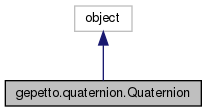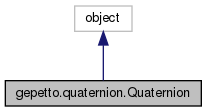gepetto.quaternion.Quaternion Class Reference
Inheritance diagram for gepetto.quaternion.Quaternion:

Collaboration diagram for gepetto.quaternion.Quaternion:

Public Member Functions | |
| def | __init__ (self, args) |
| def | __str__ (self) |
| def | __neg__ (self) |
| def | __add__ (self, other) |
| def | __sub__ (self, other) |
| def | __mul__ (self, other) |
| def | __rmul__ (self, other) |
| def | __abs__ (self) |
| def | conjugate (self) |
| def | inv (self) |
| def | __div__ (self, other) |
| def | __pow__ (self, n) |
| def | normalize (self) |
| def | normalized (self) |
| def | toRotationMatrix (self) |
| def | toRotationVector (self) |
| def | copy (self) |
| def | toRPY (self) |
| def | fromRPY (self, R, P, Y) |
| def | toTuple (self) |
| def | fromTwoVectors (self, a, b) |
Public Attributes | |
| array | |
Detailed Description
Quaternion class : ------------------ A quaternion has a scalar part and a vector part. In this class the quaternion is represented as an array of 4 elements : - the first element is the scalar part - the next 3 elements represents the vector part One can acces to the array directly with the attribute "array" e.g. q1=Quaternion(1,0,0,0) --> q1.array A quaternion can be instanciated with 1, 2 or 4 elements (see : __init__() for more information). It can also return a rotation vector, a rotation matrix, or a SO3 (see the methods : to...() for more information).
Constructor & Destructor Documentation
◆ __init__()
| def gepetto.quaternion.Quaternion.__init__ | ( | self, | |
| args | |||
| ) |
Instanciation of the quaternion with 1, 2 or 4 arguments :
-----------------------------------------------------------
This creates a 4-sized array (self.array) representing the quaternion
with the first element representing the scalar part
and the 3 others the vector part.
With 4 arguments :
------------------
- the first one is used as the scalar part,
the other three as the vector part.
With 2 arguments :
------------------
- the 1-sized argument is used as the scalar part,
the 3-sized argument is used as the vector part.
With 1 argument :
-----------------
- if it is a quaternion it will create a copy of this quaternion.
- if it is a scalar, the scalar will be used as the scalar part
and the vector part will be set at (0,0,0).
- if it is an array, matrix, tuple or list of 4 elements,
the first element is used as the scalar part
and the rest as the vector part.
- if it is an array, matrix, tuple or list of 3 elements,
the 3 elements are interpreted as a rotation vector,
this creates a quaternion representing the same rotation.
- if it is a to 2 dimension array convertible array, matrix, tuple
or list with at least (3*3) elements,
the upper left (3*3) elements are interpreted as a rotation matrix,
this creates a quaternion representing the same rotation.
- if it is an instance of SO3, quaternion is built from rotation
matrix.
With 0 arguments :
------------------
If no argument is given, than the quaternion will be set by default
to with the scalar part set to 1 and the vector part to (0,0,0).
(this is the neutral element for multiplication in quaternion space)
To create a quaternion from Roll, Pitch, Yaw angles :
-----------------------------------------------------
first instanciate a quaternion and than use the method fromRPY()
to change the values of it to the dezired ones.
e.g. : quat().fromRPY(R,P,Y)
Member Function Documentation
◆ __abs__()
| def gepetto.quaternion.Quaternion.__abs__ | ( | self | ) |
Returns the norm of the quaternion.
◆ __add__()
| def gepetto.quaternion.Quaternion.__add__ | ( | self, | |
| other | |||
| ) |
If other is not a quaternion it is casted to a quaternion, the elements are added one to one.
◆ __div__()
| def gepetto.quaternion.Quaternion.__div__ | ( | self, | |
| other | |||
| ) |
If other is not a quaternion it is casted to a quaternion, the result of the quaternion multiplication with the inverse of other is returned.
◆ __mul__()
| def gepetto.quaternion.Quaternion.__mul__ | ( | self, | |
| other | |||
| ) |
If other is not a quaternion it is casted to a quaternion, the result of the quaternion multiplication is returned.
◆ __neg__()
| def gepetto.quaternion.Quaternion.__neg__ | ( | self | ) |
Returns a quaternion which elements are the opposite of the original, (this opposite quaternion represents the same rotation).
◆ __pow__()
| def gepetto.quaternion.Quaternion.__pow__ | ( | self, | |
| n | |||
| ) |
Returns quaternion**n with quaternion**0 = Quaternion(1,0,0,0).
◆ __rmul__()
| def gepetto.quaternion.Quaternion.__rmul__ | ( | self, | |
| other | |||
| ) |
other is casted to a quaternion, the result of the quaternion multiplication is returned.
◆ __str__()
| def gepetto.quaternion.Quaternion.__str__ | ( | self | ) |
String representation of the quaternion.
◆ __sub__()
| def gepetto.quaternion.Quaternion.__sub__ | ( | self, | |
| other | |||
| ) |
If other is not a quaternion it is casted to a quaternion, the elements are substracted one to one.
◆ conjugate()
| def gepetto.quaternion.Quaternion.conjugate | ( | self | ) |
Returns the conjugate of the quaternion.
◆ copy()
| def gepetto.quaternion.Quaternion.copy | ( | self | ) |
Returns a copy of the quaternion.
◆ fromRPY()
| def gepetto.quaternion.Quaternion.fromRPY | ( | self, | |
| R, | |||
| P, | |||
| Y | |||
| ) |
Set the values of the quaternion to the values of a unit quaternion
representing the same rotation as the one performed by Roll Pitch Yaw :
- A rotation of R (Roll) about the original x-axis,
followed by a rotation of P (Pitch) about the original y-axis,
followed by a rotation of Y (Yaw) about the original z-axis.
- Or otherwise a rotation of Y about the original z-axis,
followed by a rotation of P about the new y-axis,
followed by a rotation of R about the new x-axis.
◆ fromTwoVectors()
| def gepetto.quaternion.Quaternion.fromTwoVectors | ( | self, | |
| a, | |||
| b | |||
| ) |
Return a quaternion build representing the rotation between the two vectors. In other words, the built rotation represent a rotation sending the line of direction a to the line of direction b, both lines passing through the origin. Equations from Eigen https://eigen.tuxfamily.org/dox/classEigen_1_1Quaternion.html#title13
◆ inv()
| def gepetto.quaternion.Quaternion.inv | ( | self | ) |
Returns the inverse of the quaternion.
◆ normalize()
| def gepetto.quaternion.Quaternion.normalize | ( | self | ) |
Changes the values of the quaternion to make it a unit quaternion representing the same rotation as the original one and returns the updated version.
◆ normalized()
| def gepetto.quaternion.Quaternion.normalized | ( | self | ) |
Returns the unit quaternion representation of the quaternion without changing the original.
◆ toRotationMatrix()
| def gepetto.quaternion.Quaternion.toRotationMatrix | ( | self | ) |
Returns a (3*3) array (rotation matrix) representing the same rotation as the (normalized) quaternion.
◆ toRotationVector()
| def gepetto.quaternion.Quaternion.toRotationVector | ( | self | ) |
Returns a 3-sized array (rotation vector) representing the same rotation as the (normalized) quaternion.
◆ toRPY()
| def gepetto.quaternion.Quaternion.toRPY | ( | self | ) |
Returns a 3-sized array with representing the same rotation
as the (normalized) quaternion. With :
- the first element representing the Roll,
- the second the Pitch
- the third the Yaw
Where Roll Pitch and Yaw are the angles so that the rotation
with the quaternion represents the same rotation as :
- A rotation of R (Roll) about the original x-axis,
followed by a rotation of P (Pitch) about the original y-axis,
followed by a rotation of Y (Yaw) about the original z-axis.
- Or otherwise a rotation of Y about the original z-axis,
followed by a rotation of P about the new y-axis,
followed by a rotation of R about the new x-axis.
◆ toTuple()
| def gepetto.quaternion.Quaternion.toTuple | ( | self | ) |
Return quaternion as a tuple a float starting with real part.
Member Data Documentation
◆ array
| gepetto.quaternion.Quaternion.array |
The documentation for this class was generated from the following file:
- src/gepetto/quaternion.py
